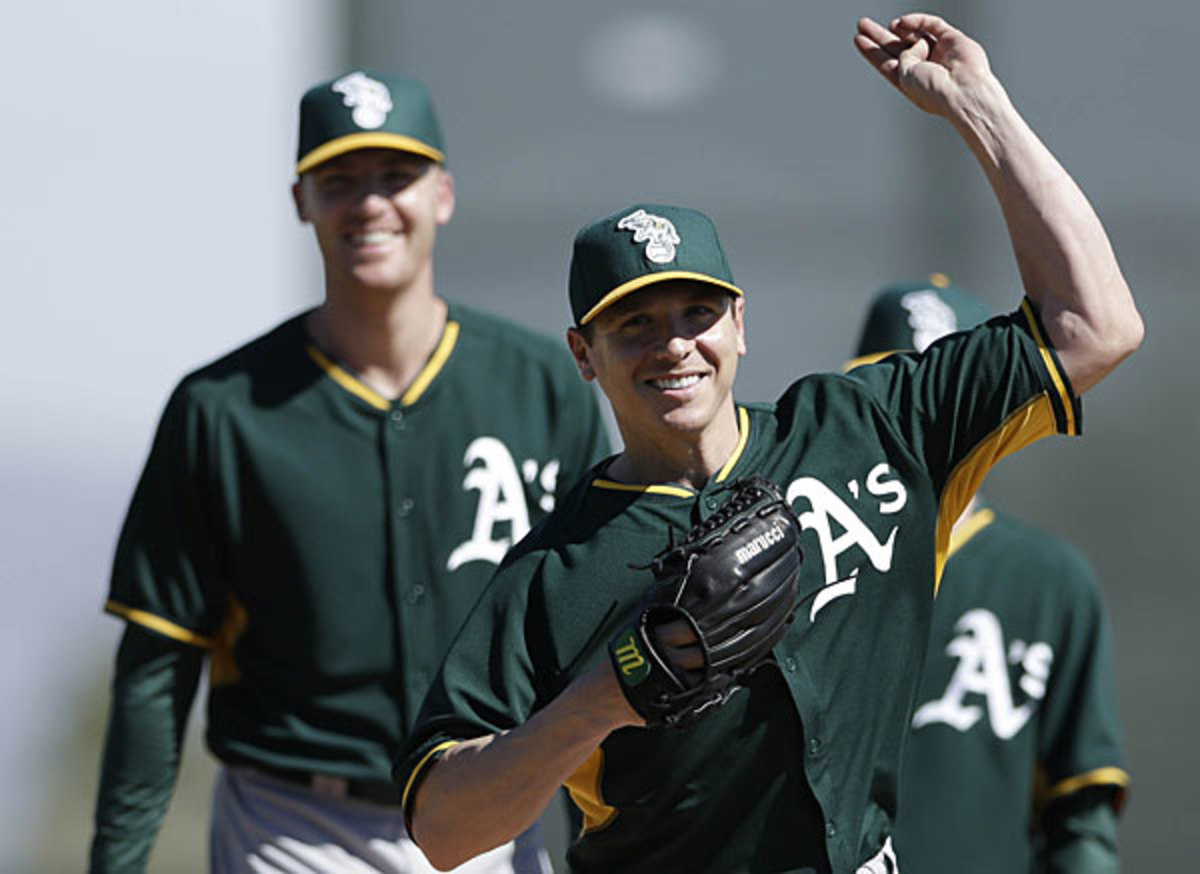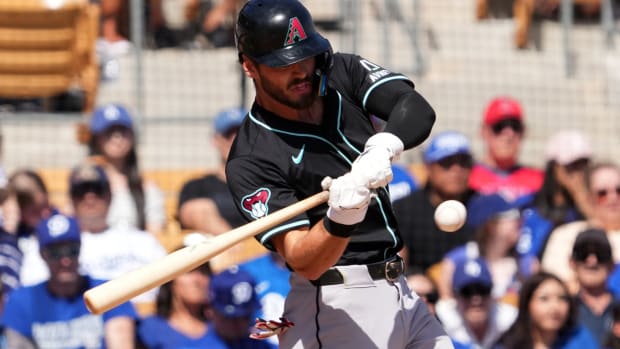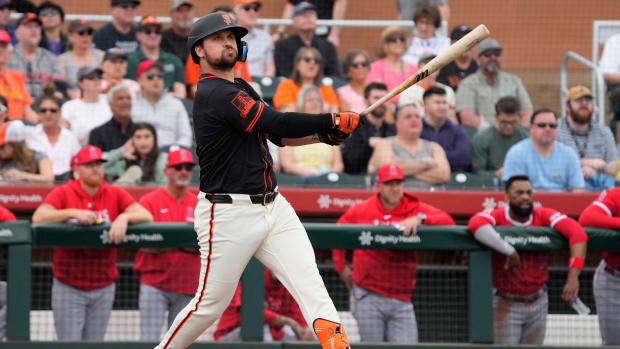
Spring training preview: American League West
The A's added reliever Eric O'Flaherty (left) and starter Scott Kazmir to bolster their pitching. (Gregory Bull/AP)
Over the next few days, Cliff Corcoran, Jay Jaffe and Joe Lemire will break down what to watch in each team’s camp as part of SI.com’s spring training preview by looking at the Big Question, Big Position Battle and Big Prospect for all 30 clubs. Teams are listed by their order of finish from 2013. Note: The Big Prospect is a player who will be in major league camp but has not yet debuted in the major leagues.
Oakland Athletics
Big Question:Is a dominant bullpen the new market inefficiency?
For as long as Billy Beane is the general manager and the franchise is cash-starved, the A’s will forever be examined for novel, game-altering trends. It’s certainly attention-grabbing when Oakland, which already had the majors’ sixth-best bullpen ERA (3.22), trades for a closer making eight figures (Jim Johnson); swaps an outfielder with power (Seth Smith) for one of the game’s most dominant set-up men (Luke Gregerson); and then signs the reliever with the sport’s best ERA over the last three seasons (Eric O’Flaherty, 1.45). O’Flaherty, who signed a two-year deal, is recovering from Tommy John surgery and won’t be ready until midseason.
Those three high-profile additions could capably fill out the back end of most teams’ bullpens, but they aren’t alone, as premier young relievers Ryan Cook and Sean Doolittle both return. There has been some attrition, with closer Grant Balfour and set-up men Jerry Blevins and Pat Neshek no longer with the club. But with the influx of talent, the A’s will consistently be able to deploy dominant arms in the sixth, seventh, eighth and ninth innings, which should relieve some pressure off the mostly young starting pitchers so that they won’t have to pitch as deep into games. The average length of starts in the majors has declined over the past few decades, and it seems this deep, mega-watt bullpen is Oakland’s answer to combat the soft underbelly of the middle innings.
Big Prospect:Addison Russell, SS
Russell, who only turned 20 in late January, was the youngest player in any big league camp last season. He makes a return engagement this spring and is getting closer to reaching Oakland. Ranked as the game's seventh-best prospect by Baseball Prospectus, Russell showed advanced plate discipline in High A ball (.377 OBP) while filling his baseball card with 85 runs, 29 doubles, 10 triples, 17 homers and 21 stolen bases in 107 games at that level. Current shortstop Jed Lowrie is a free agent after the 2014 season -- which could be perfectly timed with Russell’s readiness.
Big Position Battle:Nos. 4-5 starters
Veteran lefty free-agent Scott Kazmir and young righthanders Jarrod Parker and Sonny Gray ought to be secure in the first three rotation spots, but Oakland has a logjam of quality contributors competing for the final two openings. Righthanders A.J. Griffin (3.83 ERA in 200 innings) and Dan Straily (3.96 ERA in 152 1/3 innings) are probably the leading candidates with lefthanders Tommy Milone (4.14 ERA in 156 1/3 innings) and Drew Pomeranz (split season between Triple A and the majors with the Rockies). The young Pomeranz, acquired from Colorado in a trade for Brett Anderson, is intriguing. A former No. 5 overall draft pick, he was the centerpiece of the Indians’ trade for Ubaldo Jimenez in 2011, but he fared poorly with the Rockies. His raw talent, however, is undeniable.
Texas Rangers
Big Question:Can Prince Fielder and Shin-Soo Choo restore balance to the Rangers' lineup?
The departure of Josh Hamilton, the injuries to Lance Berkman and the underwhelming seasons from A.J. Pierzynski, Mitch Moreland and David Murphy dropped the Rangers to 25th in the majors in terms of offensive production from the left side of the plate (.689 OPS) in 2013. To compensate -- and then some -- Texas traded for first baseman Prince Fielder and signed outfielder Shin-Soo Choo. Even in his career-worst season, Fielder swatted 25 homers and had an .819 OPS for the Tigers; in his new hitter-friendly home ballpark, he may see a return to his career averages of 35 home runs and a .918 OPS. Choo had an .885 OPS for the Reds last year and has an .854 mark for his career.
Big Prospect:Rougned Odor, 2B
The Rangers have been brimming with up-the-middle prospects for years -- the current starting trio of shortstop Elvis Andrus, second baseman Jurickson Profar and centerfielder Leonys Martin all came from their system -- and Odor is next in that lineage. The lefty tore up High A and Double A as a teenager last season, hitting for a .305/.365/.474 batting line with 32 stolen bases, and his glove “should be plus,” says BP. Odor, who turned 20 earlier this month, is blocked at the big league level for now but could be second-half depth or a suitable injury replacement in 2014.
Big Position Battle:Catcher
Both Pierzynski and Geovany Soto were free agents this winter, and while Pierzynski left for Boston, Soto returned on a $3.05 million deal. Later, Texas signed former Blue Jays backstop J.P. Arencibia for $1.8 million after he was non-tendered prior to the arbitration process.
Soto has had two star-caliber seasons in his career, though they were back in 2008 and '10. He was dismal in 2012 before rallying to a solid .794 OPS and nine homers in limited playing time (184 plate appearances) with the Rangers last season. Arencibia, meanwhile, has averaged 21 home runs the past three seasons but saw his OPS drop from .720 to .710 and then to .592 last year. The biggest reason for that latter mark is a .227 OBP that would have been the worst in the majors if he'd had the five additional plate appearances necessary to qualify.
It’ll be interesting to see how the timeshare plays out. Soto has much better career numbers against lefties (.868 OPS) than righties (.737), but those numbers were reversed in 2013: .656 against lefties and .874 against righties. Arencibia has a .655 career OPS against righthanders (.594 in 2013) and a .697 against lefthanders (.588 in '13). The deciding factor may be how each handles the team's pitching staff.
Los Angeles Angels
Big Question:How will Albert Pujols and Josh Hamilton look?
The high-priced sluggers both had disappointing seasons in Anaheim last year. Pujols’ injury-shortened season ended after 99 moderately productive games (by his standards, at least), while Hamilton struggled through 151 games and hit just 21 homers with a .739 OPS, a far cry from his 43 and .930 from the previous season with Texas.
The Angels ranked 16th in OPS by their No. 3 hitters last season and 24th in OPS at the No. 4 spot in the lineup, nowhere near the production one would expect when paying the primary inhabitants of those batting-order positions more than $20 million each. In 2014, Pujols, 34, has entered camp early and fully healed; Hamilton, 33 in May, has gained more than 20 pounds to improve his power. The two hope they are more physically ready, and they have a new hitting coach to support them in Don Baylor.
Big Prospect:Taylor Lindsey, 2B
The 22-year-old supplemental first-round pick in 2010 is the organization’s No. 1 prospect according to both Baseball America and Baseball Prospectus. A lefthanded hitter, Lindsey swatted 17 homers with a .780 OPS in Double A last season. He’s probably not a future star but can be a solid everyday player who eventually pushes Howie Kendrick and competes with Grant Green at second base.
Big Position Battle:Leadoff hitter
The Angels’ starting nine is basically set and the rotation is too -- Mark Mulder's Achilles heel injury has stopped his comeback attempt before it could really begin -- but the ordering of the lineup remains to be seen, starting right from the top. Manager Mike Scioscia has said that intends to bat Mike Trout second, where he made 89 of his 157 starts last season (with only 18 coming at leadoff). That means the likely candidates to bat first are lefthanded-hitting Kole Calhoun (.347 OBP in 222 plate appearances in 2013) and switch-hitting Erick Aybar (.301 OBP in 589 PAs).
Seattle Mariners
Big Question:How much have the Mariners really changed with Robinson Cano?
Seattle hasn't cracked .500 since its 85-win season in 2009, and keeping pace with the Athletics, Rangers and Angels this season won't be easy. Cano arrives with a $240 million contract on the heels of four straight seasons in which he was named an All-Star and finished in the top-six in AL MVP voting. He is, almost indisputably, the game’s best second baseman and one who has been worth about 7.5 wins per season since 2010 (according to Baseball-Reference.com’s WAR).
BISHOP: A day in the life of Robinson Cano at his home in the Dominican Republic
That’s a hearty boost, but it alone won’t be enough to return the Mariners to the postseason for the first time since 2001. Cano's contract, however, is about more than just on-field production: it’s about the credibility that comes with luring one of the game’s best, setting an example and becoming an attractive destination for future players, too. Cano was always deferential in New York -- where the team belonged to Derek Jeter and the rest of the Core Four -- but will he and Felix Hernandez lead a turnaround in Seattle?
Big Prospect:Chris Taylor, SS
With Taijuan Walker, James Paxton and Mike Zunino having already made their big league debuts and lefthander Danny Hultzen out for the year after shoulder surgery, the Mariners don’t have as many elite, nearly major-league-ready minor leaguers in camp as they have in recent years. (Last year’s top pick, D.J. Peterson, probably qualifies, but he’s not in big league camp.) One rising prospect of note is Taylor, whom BP describes as “a polished college player” (one of five Virginia alums in the Mariners’ organization) and "above-average leather at short." Taylor had an .865 OPS split between High A and Double A and can swipe some bags; he was the organization's minor league player of the year and acquitted himself well in the Arizona Fall League.
Big Position Battle:Shortstop
After Brendan Ryan was traded to the Yankees, Brad Miller became Seattle's everyday shortstop, and Nick Franklin took over at second base. Now, as you may have heard, the Mariners spent a lot of money on a new second baseman, which puts Franklin and Miller in direct competition at shortstop this spring. (The aforementioned Taylor won't join the competition until probably mid-season.)
Both players debuted last season: Franklin is a switch-hitting former first-round pick who hit .225/.303/.382 with 12 home runs in 102 games; Miller is a lefty-swinging former second-round pick who had a .265/.318/.418 batting line with eight homers in 76 games last year. Both were worth about two wins above replacement and have upside.
Houston Astros
Big Question:Will the Astros start moving forward?
Houston is already in uncharted territory with a third straight No. 1 overall pick coming this June -- thanks to three straight seasons of having the worst record in the majors -- but that ignominious streak ought to end in 2014, even if the Astros will probably still be relegated to a bottom-five record.
Houston has the top farm system in baseball, according to ESPN’s Keith Law, and some of those players will be ready to make an impact this year. Also, the franchise opened its purse strings a bit to sign starters Scott Feldman and Jerome Williams, relievers Jesse Crain, Chad Qualls and Matt Albers and pay for centerfielder Dexter Fowler, whom they acquired in a trade with Colorado. These are merely incremental improvements but the team will have to show even marginal progress before it can think about luring elite talent to town.
Big Prospects: The 1-1s
The prospect most on the verge is centerfielder George Springer; GM Jeff Luhnow has said he’ll claim a lineup spot at some point this year. Springer, after all, is already 24 and had a 1.011 OPS with 37 home runs and 45 stolen bases in Double A and Triple A last year. But the most intrigue this spring will follow shortstop Carlos Correa and righthanded starter Mark Appel, the back-to-back No. 1 overall picks who are making their debuts in big league camp.
Correa, who turned 19 in September, dominated the Midwest League in his first full professional season, hitting for a .320/.405/.467 slash line and playing above-average defense. He will probably reach Houston in 2015. Appel, meanwhile, pitched only sparingly last summer after he was picked first out of Stanford. His minor league ascent will be quicker, most likely resulting in his big league debut sometime this summer.
Big Position Battle:First base
Jesus Guzman
Marc Krauss
Diamondbacks
Brett Wallace



































